Where to go in Switzerland on a short trip: Alps, lakes, and cities
Switzerland is an extremely popular country for those planning multi-stop tours around Europe, yet very few potential first-time visitors actually know specifically where they want to go. Everyone seems to know that it has the most beautiful views of the Alps and some very impressive cities, but there are actually many misconceptions among casual trip planners, so I’d like to clear most of that up below. The places to visit in Switzerland are not obvious until you’ve been there yourself or done many hours of research, so the list below should be a short cut.
I get hundreds if not thousands of itinerary questions for people who are considering a Eurail trip around Europe, and most people just include the word “Switzerland” among a list of cities like Paris, Rome, and Berlin that they want to visit. So where in Switzerland should you go if you can only make a few stops at most? I’ll answer that question below.
Note: This article was expanded and updated in February, 2024.
Switzerland is about outdoor views rather than city visits
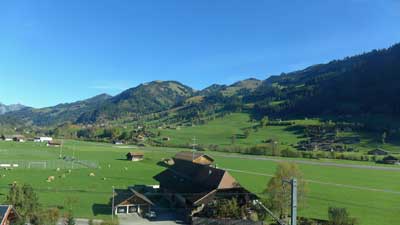
Geneva is a very famous city (though not for tourism reasons) on a lovely lake of the same name, but it’s also notoriously dull and lacking distinction. Rick Steves puts it well by saying that “Geneva is pleasantly situated on a lake, like Buffalo or Cleveland.” The point is, you don’t want to go to Geneva unless you’ve got something specific in mind that you want to see there.
Switzerland's cities in summary
Zurich – The largest city, very expensive, geared towards business travelers. It’s generally a pretty and very well-run city that you would enjoy if you visited, but it’s not nearly as interesting as the likes of Vienna, Munich, or of course Paris.
Geneva – Second largest city, in the French part of the country, no major sights. Again, if you visited you’d be very impressed by it and get some great photos, but it’s not worth your time unless you know someone there. There’s an impressive fountain in the lake and you can usually see it from the train as you go through the city, but it’s not really worth going there and staying more than an hour or so.
Basel – Bordering France and Germany, no major sights. It has the famous art market each year, and aside from that it’s even duller than the ones above. Again, if you visited you’d be impressed, but if you later compared photos with friends who went to the Lauterbrunnen Valley instead, you’d kick yourself for going to Basel.
Lausanne – Near Geneva in the French part of the country, very hilly, and certainly more interesting than Geneva.
Bern – The capital, compact, on a lovely river, some interesting sights and the best Swiss city to get a feel for the culture. Bern is fairly close to Interlaken (which we will discuss below) and it can be a great day trip from there, especially on a day where it is foggy and/or rainy in the mountains (and this happens a LOT).
How much time and which Swiss cities to visit?
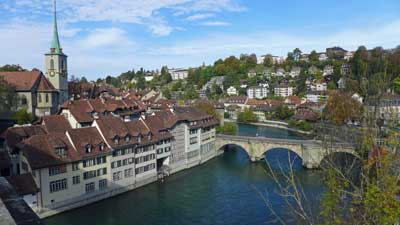
Many people (me included) don’t feel as if they’ve scratched the surface of a new country if they haven’t spent at least a day or two in the largest city. Zurich is certainly pleasant and a useful transit hub so spending one or two nights there wouldn’t be a major mistake. But Zurich isn’t even close to being a city like Paris, Rome, Berlin, Amsterdam, or even Vienna. If you skip it in favor of spending more time in the outdoors, you won’t be missing much.
The 2 Swiss places to focus on for short visits
Interlaken – If you want the best possible Alpine views and activities, head to the Interlaken area, which will be described in detail below.
Lucerne – The traditional Swiss tourist retreat, Lucerne is a small city with interesting culture and sights, that is gorgeously set on a lake with plenty of top activities surrounding it.
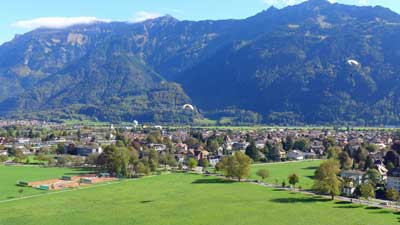
What about Zermatt for Alpine views?
Zermatt is a remote car-free village in southern Switzerland that is famous for being the place to see the Matterhorn mountain. It’s also a busy ski resort area, and aside from that, there isn’t much to see or do here. It’s on a private rail line, so it’s more complicated and usually more expensive to reach than Interlaken.
In other words, unless you’ve irrationally placed “Seeing the Matterhorn in person” on your so-called bucket list, skip Zermatt and head to Interlaken on a shorter visit. You won’t be sorry. If you already have enough time in your visit for the main sights around Interlaken and Lucerne and you want to also see the Matterhorn, then by all means go and you’ll enjoy it. There are quite a few other car-free villages in the Lauterbrunnen Valley near Interlaken, so they are not as novel in Switzerland as one might expect.
A weekend in Switzerland?
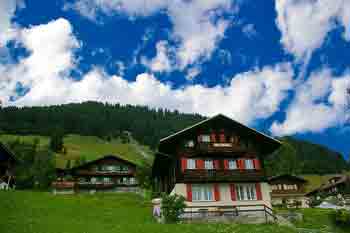
One challenge is that neither has an international airport so you’ll either be flying into Zurich or perhaps Geneva.
Train times from Zurich to Lucerne to Interlaken and back
- Zurich Airport to Lucerne: 1 hour 10 minutes by train
- Lucerne to Interlaken: 2 hours by train
- Interlaken to Zurich Airport: 2 hours 15 minutes by train
As you can see with the travel times above, Zurich Airport to Lucerne is a fairly short trip, but once you add Interlaken into the mix (even if you skip Lucerne) the travel time starts to add up for a weekend visit. With this in mind it’s probably best to just choose one of them and save the other one for another trip.
Lucerne is gorgeous, but the Lauterbrunnen Valley near Interlaken is really the star of the show, so I’d recommend going there first and doing Lucerne on another trip.
What about the Swiss Travel Pass?
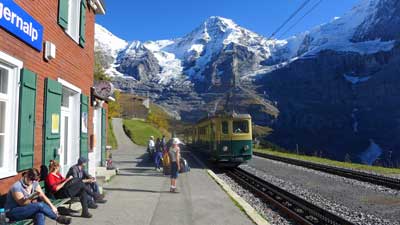
The bottom line is that if you are coming to Switzerland for at least 3 days and you want to take 2 or more of the amazing scenic rail journeys that the country is famous for, the travel pass is probably a good deal. It also provides 50% discounts on the Schilthorn cable car and 25% off the Jungfraujoch mountain railway. Both of those are quite expensive on their own, but extremely worthwhile, so the discount is helpful.
The Half Fare Card is probably a better deal for most people
The Swiss Travel Pass is a good deal for those who are going to be spending at least 2 or 3 days riding the rails and seeing Switzerland that way. But if you are mostly going to be focusing on Interlaken and Lucerne and the mountain sights, the Half Fare Card is the best option. For CHF120 (about US$134) you get the card that is good for 30 days and gives you a 50% discount on all trains, cable cars, mountain railways, and other sights and attractions. If you are doing either Schilthorn or Jungfraujoch, the Half Fare Card practically pays for itself with just one of those.
>>>Buy the Swiss Half Fare Card
Many people have questions about the Swiss Half Fare Card so I will explain it a bit here. You can actually buy half price train tickets for travel within Switzerland any time you want and you will see that option when you go to buy them online. The only thing is you have to have and present a valid Half Fare Card when you get on the train and are asked to see your ticket. In other words, you can buy a half fare train ticket today and buy a Half Fare Card just before you get on that train months in the future, and you are fine.
How and why visit the area around Interlaken
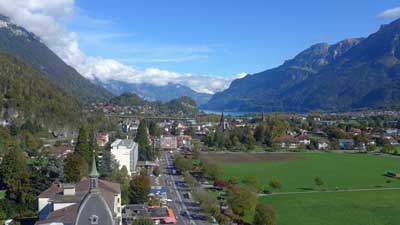
You can see everything discussed below by actually staying in a hotel in Interlaken, but it’s not the Alpine experience that you get if you stay in one of the small villages nearby. You can reach those villages in 20 to 40 minutes from the Interlaken Ost (East) train station, and it’s much easier than it sounds.
The 3 best places to stay to visit the Swiss Alps
Lauterbrunnen – A private train line runs from Interlaken Ost station to the end of its line in Lauterbrunnen. There’s a lovely waterfall here and great hiking trails, but you should probably only stay here if you can’t get to one of the villages mentioned just below. It’s a great little transit hub and it’s definitely gorgeous, so it can be worth a night if you’ve got one to spare.
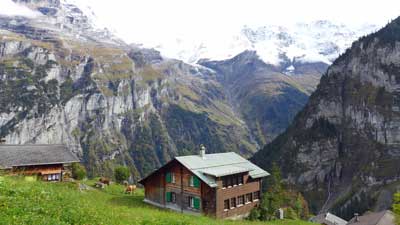
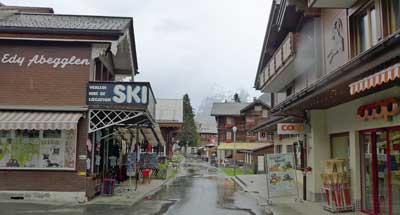
Where to stay in Interlaken and the Lauterbrunnen Valley (with pics)
I get so many questions about where to stay in the Interlaken area that I decided to write a longer version of it and load it with huge photos so readers can get a better feel for each option. I also included recommendations for affordable and well-located photos in each area.
>>>Where to stay in Interlaken and the Lauterbrunnen Valley New for 2024!
The unforgettable things to see here (if the weather is decent)
Schilthorn observation deck and restaurant
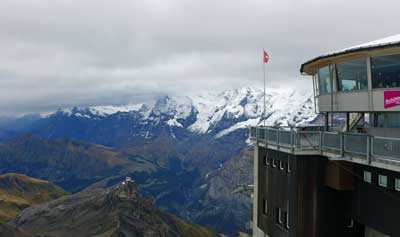
There is a rotating restaurant (with prices similar to normal Swiss restaurants) and a bizarre and anachronistic James Bond attraction based on it being a key location in the 1969 movie On Her Majesty’s Secret Service. The Bond thing is included with the lift, and it’s worth a look.
But the main thing you come here for is the 360-degree view from one of the highest peaks in Europe. Again, the weather here is key, but fortunately all the locals track the visibility on a minute-by-minute basis. If it’s clear up top while you are in the area, it would be a terrible shame to skip it based on the high price. But even if it’s cloudy up top, there are still plenty of wonderful things to see and do in the villages below.
Jungfraujoch observation area
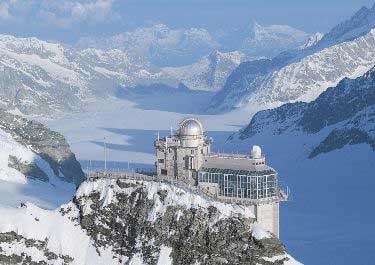
The views from the top are similar to the views from Schilthorn, from the other side of the Lauterbrunnen Valley. Once on top you can have lunch, hike, or even go sledding. It’s also quite expensive at nearly US$200 round-trip unless you have a Swiss Pass or a Eurail Pass for discounts, and it takes most of your day, but you’ll never forget the views from the top.
Harder Kulm mountain and Two Lakes Bridge Observation Deck
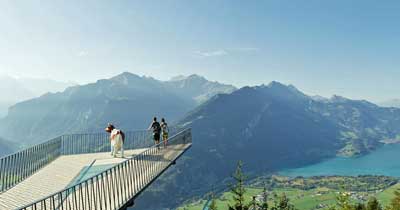
There’s a revolving restaurant about 10 minutes’ walk from the station at the top, which is definitely an unforgettable place for lunch if you’ve got time. It’s not as expensive as you might expect, at least compared to normal restaurants in Switzerland.
The Harder Kulm Railway goes from early April through late November each year. If you are only in Interlaken for one day and/or you are on a strict budget, this is the fastest and best way to get amazing Alpine views in the area.
Getting from Interlaken to Gimmelwald and Mürren
Getting up to these villages sounds complicated and time consuming, but it’s actually fast and easy once you get there. This little guide should help.
Arrive in Interlaken
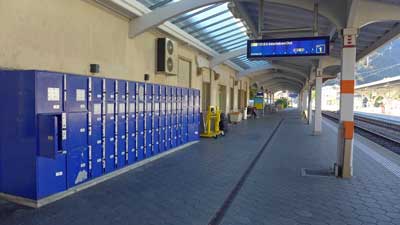
Once you arrive at the Interlaken Ost train station, head for the ticket windows in the office and buy a ticket to your final destination (Lauterbrunnen, Gimmelwald, or Mürren). Eurail passes are good for 25% discounts on the rest of the trip, but not for the whole thing.
From Interlaken Ost to Lauterbrunnen
The private train leaves Interlaken Ost every 30 minutes and arrives in Lauterbrunnen 20 minutes later. If you are staying in Lauterbrunnen then you are probably walking distance from your hotel when you reach the station.
From Lauterbrunnen to Gimmelwald
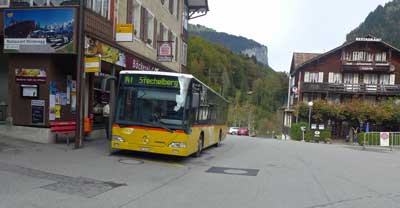
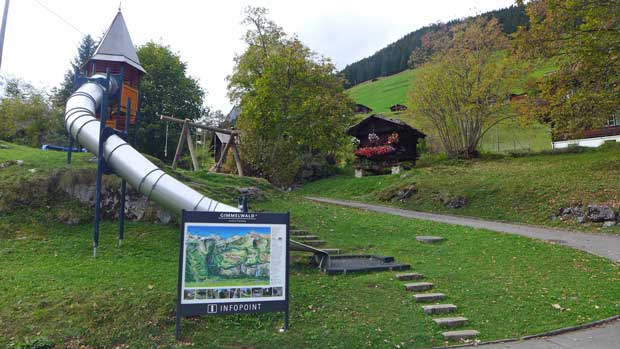
From
Gimmelwald to Mürren
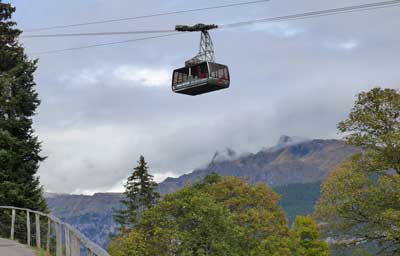
Recommended hotel and hostel in Gimmelwald
I get asked all the time about where to stay in Gimmelwald, so here it is:
Hotel: Esther’s Guesthouse
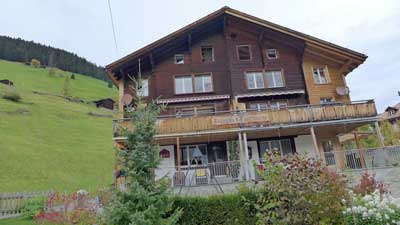
It’s run by Esther, as you might guess, and she is very friendly speaking excellent English. Each room is different and the place feels like a mountain cabin, because it is. She offers an excellent buffet breakfast in the morning, which you have to order the night before. It’s not cheap, but it’s worth it because it’s hearty and there are no other good options nearby.
Book as early as possible because this place is often the first place to sell out in Gimmelwald.
Hostel: Mountain Hostel Gimmelwald
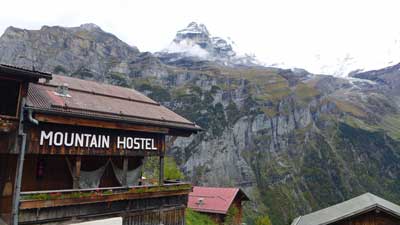
You won’t believe the views from this place, which are the same as from Esther’s except a bit lower and more unobstructed. This place also has a busy bar and restaurant that is basically the only “nightlife” in Gimmelwald. Many hikers get to bed early in this tiny village, but if you want to have a couple drinks and order a pizza or some local options, this is the place to go.
Again, book early because this place is always sold out.
Lucerne and what to do there
Luzern, as it’s spelled locally, is the other traditional holiday destination in Switzerland. Unlike Interlaken, Lucerne actually qualifies as a small city rather than a small resort town, so it’s a very nice contrast and very worthwhile.
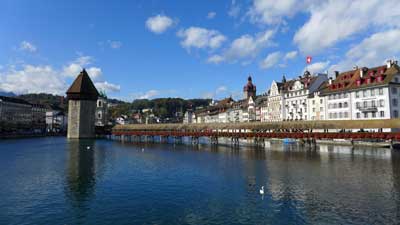
However, unlike Interlaken, the town of Lucerne itself is a great attraction and worth at least a day of exploration. This has always been a rich area so you can expect to find all of the high-end shops and boutiques along the small streets just north of the lake, but there are also many traditional shops and things to see that will appeal to anyone.
Recommended hotel in Lucerne
>>Hotel Des Alpes (3 stars with an amazing location and view)
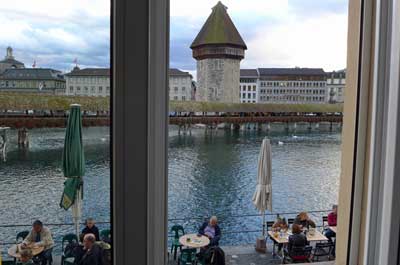
If this place is booked, which is often the case, then book a hotel as close to it as you can find or afford. The whole historic part of town surrounding it is lovely, with restaurants, bars, and high-end shops. There are also a couple of nearby supermarkets where you can buy inexpensive alcohol and picnic supplies to keep other costs down.
Spend a day in Lucerne itself
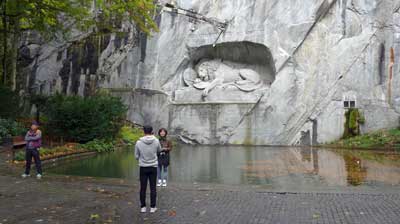
Most of the interesting part of Lucerne is in the area behind those restaurants, and it’s certainly worth doing a self-guided walking tour if not a guided one. Heading farther east you’ll come to another older part of town where the famous lion statue is located. You can’t visit Lucerne without having a look at the lion, and fortunately it’s easy and quick to reach (and it’s free).
Take a lake cruise of some kind
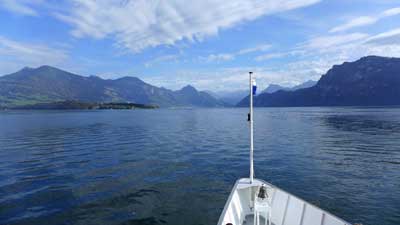
Especially in nice weather, even the short lake tour is lovely, and if you have more time you can jump off at Vitznau and do the scenic hike up Mount Rigi. There are also small lakeside villages that are ideal for a stroll and lunch stop. Long story short, there are dozens of interesting sightseeing options that are available using part of the boat tour, and the views all around are wonderful.
Visit Mount Pilatus
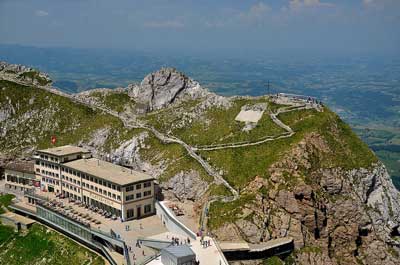
You can take the cogwheel train up and have a more or less flat hike around the summit area, and then take the gondola and cable car back down again. You can do them in the other order, and the cost is the same either way. At around US$65, this is not a cheap hike, but like most everything in Switzerland, the quality is high so it doesn’t feel like a rip-off. You can reach the cable car in 10 minutes on a public trolly bus from Lucerne.
Visit Mount Rigi
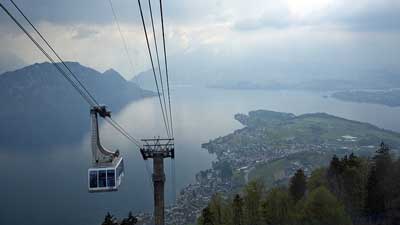
Unlike the other peaks mentioned in this article the Swiss Travel Pass covers both ways to get up and down for free. The others are 50% off with the Swiss Travel Pass or Half Fare Card, except for Jungfraujoch, which is only 25% off with the Swiss Travel Pass and still 50% off with the Half Fare Card.
Visit Mount Titlis
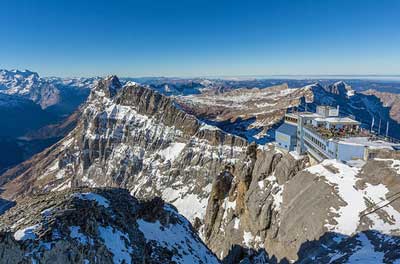
You can reach Titlis by taking a 43-minute train ride from Lucerne to Engelburg and then taking the cable car up from there. As with the others, it’s wise to check the weather immediately before you are going to depart because it can be foggy or cloudy any time of the year, but usually not for whole days at a time.
Additional photo credits
Jungfraujoch by cupweuro on Flickr, Pilatus by Tony Fernandez on Flickr, Rigi by Kosala Bandara on Flickr, Titlis by PaulSchliebs on Flickr

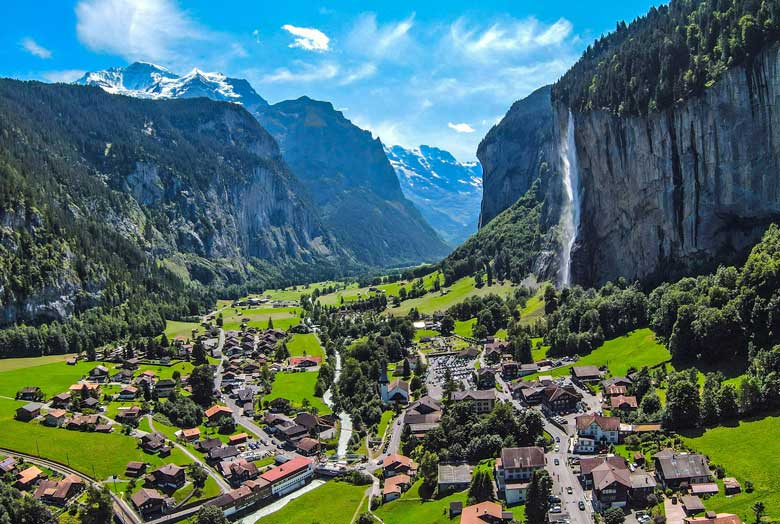
Hi,
Thanks for the really helpful article. So my husband and I would be in switzerland for around 3.5 days (effectively) around 17 – 20th March. SO would basing ourselves out of Lucerne be better or would Interlaken be better. Or should we divide time between the places? Also we were planning to do Mt. Titlis. So would that be a good option or should we consider doing Jungfrau or Rigi or Pilatus? We are mainly interested in the scenic beauty.
Thanks in advance.
Purba,
I’m happy the article is helpful, and I can’t really stress enough how different Lucerne and Interlaken are. Lucerne is a really lovely and scenic town on a photogenic lake, and most people love it there. Interlaken is a nice enough town but the key draw is that it’s at the base of the most scenic and easily accessible parts of the Swiss Alps. As mentioned above, the best place to go for Alpine beauty in a short time is the area just above Interlaken in either the tiny village of Gimmelwald or the large village of Murren. From there you can also visit Jungfrau, although you’ll be able to see the peak from anywhere in that area. I went up to the Shilthorn observation deck on my most recent trip, and if the weather is clear there is no finer view anywhere.
Rigi and Pilatus are nice, but they are nothing compared to the actual Alps near Interlaken. I believe Mt Titlis is more remote, so getting there might take most of a day, while the Jungfraujoch railway and the Shilthorn Cable Car can be done in a few hours each from the Interlaken area.
So I’d recommend 2 days in Gimmelwald (not nearby Grindelwald) or Murren, which will hopefully give you enough time for a clear view of all the peaks. The weather there changes frequently, so it might be clear in the morning and covered in clouds a few hours later, or vice versa.
And then spend a day and a half in Lucerne. Again, the town itself is really nice and you’ll have time for a short boat tour on the lake, with enough time to do some hiking or go up one of those mountains by cable car as well.
Let me know if you have any other questions. -Roger
Hi,
Thanks for the nice articles. I am planning a visit by 3 or 4 week of march with my wife and 2 children. My aim to enjoy the scenic beauty, nature and country side views. Is it a good time ?
Ajith,
Yes, I think March is a really nice time in Switzerland. Most of the country is green all year and there will be plenty of snow in the Alps to make it look even nicer than in summer. The rain is spread pretty evenly over the year (actually a bit more in summer), so it will probably be dry. It will be quite cool, and rather cold up in the mountains, but that’s the case much of the time there. Enjoy your trip. -Roger
Thanks for so many crisp replies from you. How about St Gallen/ Santis area for staying 02 days. I am planning a trip to Switzerland in end May / early Jun for about 08 days with my wife. I am planning to stay at air bnb accommodation ( yet to be booked) and I need to know which other places to stay.
Sudhakar
sudhakar,
To be honest, I don’t know much about St Gallen and I haven’t been there. However, I have recently spent time in the Appenzell area, which is about 15km to the south. I assume that it’s similar in that it’s a rural area known for cows and cheese and traditional life. Ah, now I notice that Santis is just south of Appenzell, so it IS the same area. So yes, I think it would be two lovely days if you are looking for something very mellow and serene. My hunch is that most of the tourist-oriented things are actually in Appenzell, as the two places you mentioned aren’t really known on the tourist trail. Still, I think two days in that area should be very nice, although I wouldn’t recommend more time than that because you’d quickly run out of things to see and do. Have a great trip and feel free to follow up if you have other questions. -Roger
Hi Roger,
The only challenge I am facing while planning is the weather condition in march. I would be there from 27th Feb to 4th March.
I am afraid that while I am planning things, not sure howz the weather at time and which all places wlll give me the best of the view and worth and which all should I avoid going to in feb end till march 1st week.
Like for example if I am unable to see jungfraujoch due to fog, will the same climate will restrain me visiting mt. titlus or mt. Pilatus?
Similarily , will it be freezing cold there which would restrain me from enjoying out my trip or will it be moderate.
Also, I am sure some views and places or activities are more of worth in march 1st week or feb end ? what all are they..
Thanks a ton. Its really helpful to get advice from you.
Richa,
I know what you mean and those are valid concerns. Unfortunately, there is a chance of foul weather pretty much all year round in the Alps, and that includes July and August. I visited in November and it was nice most of the time I was there, but once I got up to the top of Schlitterbahn it started to fog up and an hour later you could barely see anything. I read a lot about it before I went and was also a bit surprised that this can happen in summer and winter as well.
So the best advice, which is the advice that I followed, is to try to allow at least 2 if not 3 days in the most scenic areas of Interlaken, but don’t book an exact time for a train ride or cable car. Once you get there you’ll find that all of the locals in the travel industry keep up with the local weather conditions on an hourly basis. And there are webcams in key places as well, so you can log on from your hotel and see what the views are at any moment. You just have to go as soon as you see that it’s clear, which might be right when you arrive and possible during your whole visit.
These areas are very popular with tourists year round and I don’t hear many stories of these places being fogged in for days at a time. My understanding is that these weather systems tend to blow in and then blow out a few hours later, rather than just park and stay for days. So there will be some risk, and the same has been true for everyone who has visited before.
As for the general weather, it might be freezing at night, or even during parts of the day if you stay in Gimmelwald or Murren, but these are popular tourist areas year round and they don’t get extreme cold or massive snow storms. In other words, as long as you dress in a few warm layers, you should be fine. The hotel that I stayed in provided free sturdy umbrellas for all guests, so you probably won’t have to worry about bringing one of your own.
There are loads of things to do in Lucerne in any weather. In Interlaken it’s all about the views and hiking and the cable car rides and scenic trains and such. I understand why you’d be cautious, but I really think you’ll have a great time, even if you get some foggy periods while you are there. Best of luck. -Roger
Hi Roger,
Need your suggestion for my honeymoon trip to Switzerland in march 1st week. Trip will be for a week. Suggest me what all is must see for a couple. What about a taking boat instead of train for Interlaken from lusern? Also, how about St. Mortiz
Richa,
I don’t believe there is a boat from Interlaken to Lucerne and even if there was it would take forever. If you want to do some pleasure boat trips in Switzerland then Lucerne has many great choices in a very scenic area. And I’ve only passed through St. Moritz, so I’m no expert, but it mainly has a reputation as a high-end ski resort town. In early March the luxury hotels will still be filled with very rich people, but it’s not really known for its sights otherwise. On a honeymoon trip it might be worth a look if you can afford it?
Aside from that, I think the most honeymoon-oriented place in Switzerland is Lucerne, so I’d probably spend about 3 nights there. It’s a gorgeous town that is also very tourist friendly. And of course you’ll want to spend at least 2 nights in the Interlaken area for the best Alpine sights. As I have mentioned many times, I highly recommend the tiny hillside town of Gimmelwald, which should feel even more magical on a honeymoon.
If you also want to spend a couple days in a Swiss city then I’d definitely recommend Bern. It’s fairly compact and it has a gorgeous setting. It’s also easy to reach from the other two places. If you speak fluent French then maybe Lausanne is another to consider, but most agree that Bern is the better choice.
You can get between each of these cities on trains in about 2 hours or less, and they won’t cost too much. Let me know if you have any other questions I might help with. -Roger
Hello Roger
I am planning a trip to Switzerland with my 4 year old girl. I will be staying there for 3 days around October end. I am thinking of staying in wildersill. Do you think it’s a nice place to make my base for 3 days? Can you please advice me which places should I cover in Interlaken in 3 days. I am also thinking of taking a ride on panorama trains, most probably Golden Pass and Bernina Express. I am not sure whether I can fit in both the journeys along with other sightseeing in 3 day. Also do you know how will be weather be in October end? Your advice will be much appreciated.
Regards
Lav
Lav,
I’m not actually familiar with the small town of Wilderswil, but it appears to be a close-in suburb of Interlaken, and that whole area is ideal for Alpine sightseeing. I stayed in Interlaken itself and up in Gimmelwald, and both of those are wonderful for tourists.
The Golden Pass train ride is really wonderful, but honestly I found that pretty much every train ride I took in Switzerland was pretty amazing. So in my opinion, I think if you took one scenic train ride you’d really enjoy it, and you’ll also really enjoy the train rides that take you into and out of the Interlaken area. And I also highly recommend the experience of taking the cable car up to the Schilthorn peak, as long as the weather is clear up there at the time.
I was actually in this area last October and the weather was quite nice, although it can get cloudy and even a bit rainy on short notice. I think it’s a good time to visit and it’s not too cold to enjoy, but you have to plan carefully. There are a few things that you can do when it’s cloudy or raining and they are still fantastic. But others, like the Schilthorn peak, are best when it’s clear. So if you keep track of the weather once you arrive and try to do certain things when it’s clear, you’ll really love it all and can still have a great time if it gets cloudy. Have a great trip and let me know if you have more questions. -Roger
Thanks Roger,
When you mention Bern needs a full day, do you include Murten or not ?
When you search for train time schedules in the rail website, may I know how do you type alphabets with those “2 dots” eg. Zurich ?
You went up Schiltorn(Jame Bond); on top are there ant places to walk around or hike ? Or is it just a “one scene” place where you just stay for 15 mins and leave ?
I will like to sleep in Gimmelwald too but will 4 or 5 nights there too much ? I plan for 2 days to go up the 2 peaks(Schiltorn and Jungfra a day each) and 2 days of hiking. If I am afraid of being too monotonous in one place for too many days, where shall you suggest I stay other than Gimmelwald and Murren ? In case, I cant get a bed due to summer.
In those 2 places you mentioned in Gimmelwalk, are there kitchens to self-cater for dinner meals ? I am thinking of Esther’s cheapest room, do they have more than 1 bathroom to share ?
Thanks again.
Lee,
I was just referring to Bern. I’ve read good things about Murten, but on public transport I heard that Bern is far easier.
I search for European train time tables on the free RailEurope smartphone app, which is much faster than the websites because it has the whole time table stored on the app, so it can be used offline. I’ve never needed to type in an umlaut. You just type the city name without umlauts and after a few letters you’ll see what you want among the choices. For most cities it accepts both the English spelling (like Munich) as well as the local spelling (Munchen), although in some cases (like Zuerich) it only has the local spelling. Not only can you see all of the trains going and all the connections, but it also tells you whether you’d need a reservation on a train or not.
On top of the Schilthorn there is one large complex of buildings (mostly just one building) with the James Bond thing, a huge gift shop (of course), a revolving restaurant with typical Swiss prices, a large outdoor viewing platform, and also various walking trails. When I was there (in October) it was snowing so hiking around on the dirt trails didn’t seem wise, but the main views from the concrete public areas were stunning. I had a light lunch and a few beers at the restaurant, which allowed me about 1.5 revolutions and it was excellent. The weather was getting worse by the minute, so most people were leaving about when I did. Again though, it’s all about the view and visibility. If you go, make sure you are going when it’s pretty clear up there and it’ll be worth it.
Gimmelwald is a tiny farm community that only exists because the Swiss government subsidizes the livestock operations because they are so popular with tourists, and traditionally Swiss. There might be about 30 or 40 total homes, barns, and guesthouses in town, so you could literally see it all in an hour or two. But the views are extraordinary and everything looks like it belongs on a postcard. You can hike up to Murren and back, or take the cable car one or both ways. I spent 2 nights there and then 2 more nights down in Interlaken, which seemed perfect to me. Murren has similar views, but it’s a large town filled with hotels and restaurants. I don’t think you’d want to stay in Gimmelwald for more than 2 nights. After that, Murren might be fun, or maybe Lauterbrunnen because it’s closer to several of the best hikes.
At Esther’s Guesthouse in Gimmelwald I stayed in a single room with TV and I shared a bathroom with one other single room. They have ensuite rooms as well, I believe. There is a shared kitchen and they even prepare food if you order it early in the day. You could buy groceries in Murren or in Interlaken and cook for yourself, but I ate both nights at the Mountain Hostel, which has excellent pizzas among other things. It’s expensive (maybe US$20 for a very filling pizza), but it was a worthwhile splurge for me. In most of Europe it’s pretty easy to eat a good dinner for under €5 if you need to, so I cut corners in other places and didn’t mind spending more for my time in Switzerland. -Roger
Hi Roger,
I am aware of the higher cost in Switzerland and I have read about all those places you mentioned, I have nearly all the Rick Steves books too. My biggest problem is deciding on what pass and which way to go; I still think they have a very complicated Pass system, although they simplified a little this year by doing away the flexipass. May I know the followings, it will help me to decide:
a) Have you been to Mt Pilatus, Mt Titlis(the new skywalk is very tempting) and Mt Rigi ? Wonder how is their scenery compared to Jungfrau and the James Bond one you did ? I will surely do the James Bond one after reading your last reply. Are there much to do or walk after reaching the top ? How much time shall I spend up there ?
b) How many hikes have you done ? I will do the Mannlichen – Kleine Scheidegg walk but can you recommend me any others that are as just as good or different ? I don’t mind a long hike, even if with my luggage.
c) If I get a Swiss Pass, will the bus fare from Lauterbrunnen to Mannlichen and Wengen to Lauterbrunnen covered ? Can you recommend a “postbus” scenic trip which I will not be able to see from the train ?
d) Why do you need 2 nights in Bern ? Is there so much to see there ?
e) Based on my above hiking plans and James Bond peak, where shall you suggest I should sleep other than Gimmelwald ?
f) If I wish to do all the 4 or 5 scenic railway trip with at least the best section of it, together with those places you mentioned above(time in every city kept to a minimum), and 2 or 3 hikes with 2 mountain trips in the Berner Oberland,one Mt Titlus and Lucerne, how many days minimum do I need in Switzerland,?
Thank you very much again.
Lee,
a) I haven’t been up any of those mountains, though I believe I’ve been at the base of all of them. The mountains in the Alps near Interlaken are all more dramatic than those near Lucerne.
b) I recently did the Mannlichen – Kleine Scheidegg hike and several others in and near Gimmelwald. It’s all pretty amazing, but there are better experts than me out there on hiking. I trust Rick Steves’ opinions on these things and he writes a lot about all of the main hikes.
c) I’ve never used a Swiss Pass and I agree they are confusing. My understanding is that they would cover the buses in that area, but I’m not sure about the private railways like the Mannlichen one. I had a Eurail Pass and got a discount on the private railways and cable cars.
d) Bern is pretty small and you could see it in one day if you had to. Personally, I prefer to stay 2 or 3 nights almost everywhere I go, partly because 1-night stays mean you are in transit much of the day rather than sightseeing. When I can, I love one full day where I wake up in a city and see everything I want to see, without having to check out of my hotel, store my backpack, and worry about catching another outbound train. Also, Bern is probably the best of the Swiss cities for visitors and it’s very scenic. But you can see a good chunk of it in half a day.
e) If I were you I’d book at the Mountain Hostel in Gimmelwald. I actually stayed at Esther’s Guesthouse, which is just above the Mountain Hostel, but I had dinners and hung out at Mountain Hostel each evening. If you prefer not to stay in Gimmelwald, I’d stay in Murren.
f) It would be pretty easy to tell you how many days I’d stay in Switzerland, but it sounds like you might want to move more quickly than I prefer, so it’s hard for me to answer with confidence. By the way, I think traveling fast is appropriate in some situations, especially if you are trying to do a low budget in an expensive country. Good luck. -Roger
Dear Sir,
I have trouble planning Switzerland. This will be my first visit and I will be traveling to other parts of Europe too. I am in a dilemma, I could not decide how many days and which Pass to get. To make matter worse for me,a low budget is my main constraint(time is not a problem)but I want Switzerland(more for the high scenery, snow and outdoor hikes)to be a highlight of my trip. I wish to visit Bern, Interlaken for Murren and Grimmelward(the 2 mountain trips you mentioned) and Lucerne, for Pilatus, Titlis, and Rigi(will visiting all 3 unnecessary ?) as well as all the 4 Scenic Railway routes, at least the best section of them and spare 1 or 2 days just for hiking around Murren and Grimelward. I see places rather fast so I need not spend too much time in any city, Bern, Geneva, Zurich, Lucerne may all be a few hours stop over if it helps to keep my days less to keep my expenses down.
Thank you very much and any opinions will be appreciated.
Based on my needs,can you design for me which which Swiss Pass shall I get, in case if I do not do with with a Eurail Pass ?
I missed to mention that I can be traveling in July or Auguest so I guess days will be long for sightseeing but will it be hot or short of snowy sceneries ?
If I use I Eurail Pass, I can break the journey while traveling to Austria, Germany and northern Italy.
Will this time of the year hot for hikings and short of snow scenery ?
Lee,
Switzerland can be tricky on a small budget because it is by far the most expensive country for restaurants and accommodation, not to mention most of the famous sightseeing opportunities. But it is incredible and has the best Alpine scenery in Europe, so you’ll be happy you went.
If your budget is tight then I think the Swiss Rail Pass or Swiss Travel Pass would be too expensive, but it really depends on your main goals. The individual train tickets within Switzerland are actually quite reasonable, and the price is the same no matter when you buy them (unlike all other European countries). For example, Zurich to Interlaken is between US$25 and US$35 one-way, depending on which train you take. The big expense comes in the best cable cars (mountain lifts) and the private tourist railroads, which can cost between US$100 and US$250 round-trip. If you are sure you want to take at least 2 or 3 of those, then a Swiss Travel Pass will pay for itself. If you think you might want to take 1 of them, then the Swiss Half Fare Card could be your best bet, as long as the one you want to do is covered by it.
The one I did recently was the cable car (above Gimmelwald) up to the Schilthorn and it was honestly the single highlight of my 3-month trip to Europe, even though it was partly cloudy and got worse as time went on. By the way, I’m pretty sure there is snow all year round up there. I think it cost around US$110 at the time, and I got 25% off with my Eurail Pass. It felt expensive as I was paying but I’m very glad I did it. Later that day I spoke to a guy who did the Kleine Scheidegg on the same day and he said it was also very nice, but maybe not worth the US$200 or so that it cost.
And as you know, there are about 5 or 6 famous “scenic railways” in Switzerland, and I took 2 of the better ones on that same trip. Honestly, I don’t know if it’s worth it to go out of your way to try to do several of them. What I mean by that is that literally every rail trip I took in Switzerland had pretty amazing scenery, and those heavily-promoted trips didn’t really stand out as any better. In other words, if you just buy train tickets to travel around to the various corners of Switzerland, you’ll see awesome scenery no matter what. I think those famous journeys are mostly just to help people structure trips if they can only do one or two train rides.
As for the Interlaken area, your best bet will be to book in advance at the Mountain Hostel in Gimmelwald (and Gimmelwald is not to be confused with the larger town of Grindelwald, which is located in the next valley over). Murren is 5 minutes above Gimmelwald by cable car, or 45 minutes away on foot. Gimmelwald is tiny and far more charming so I’d stay there and maybe take a walk around Murren at some point. Schilthorn is 2 more stops up the cable car from Murren, but those are the long and expensive stops. It’s only like US$6 to get from Lauterbrunnen to Gimmelwald, and a bit more to get to Murren.
Since you are trying to keep costs low and if you want to visit a city, I’d spend 1 or maybe 2 nights in Bern, and I’d skip Geneva and Zurich because there isn’t really anything special about them except that most things are insanely expensive. Lucerne is also worth 1 or 2 nights, and I believe there is a good hostel there kind of on the edge of town. By the way, the main attractions in Lucerne are the lake and the views overlooking it. But it’s not in the Alps and the views from Gimmelwald are FAR more dramatic.
So if you visit the area above Interlaken (Gimmelwald etc), and Lucerne, and Bern, then those train rides are going to be spectacular just going between them. But if you are pretty sure you want to do more of those scenic rides, a Swiss Rail Pass could save money.
And in July and August you won’t be walking through much snow in the Alps, but you will see plenty of it on the higher peaks.
Sorry that I can’t be more specific than that, but I’ll be happy to respond again if you make those decisions and are still unsure. -Roger
I am a Swiss citizen but live in Australia. I had a good laugh and could not agree more with the above article. Avoid Zurich and do the things described above. I actually grew up around Interlaken. Cheers
Hi All,
I would like to ask your advise whether it is the right time to go Switzerland on mid of Nov ?
Thanks.
Regina,
November is a tricky month in Switzerland. Lucerne is a year-round city, although November is a fairly slow month there. But in the mountain resorts in the Alps, many smaller hotels and restaurants close from early October until mid December. During these months, it’s too cold for most hikers, yet too early for snow for the winter sports visitors. Now, some hotels and restaurants are open all year round, so you can visit without a problem. But it will feel like off season and it’s not an ideal time to see and hike in the Alpine villages and such. -Roger
Hi Roger,
Thanks for sharing valuable information about Switzerland. Me and my wife are planning to visit Switzerland from 2nd October to 6th October ( I know it will be cold but couldn’t help it).
I have 2 Questions;
1) Will we be able to enjoy the sights or will they be closed in first week of october?
2) We were planning to spend 2 nights each in Lucerne and Interlaken (Skip Zurich altogether), or is it better to book all nights in Interlaken and travel to Lucerne for a day trip from there. does that make sense ?
Khemant,
Early October will be wonderful in Switzerland. Some small hotels and restaurants close from mid October until December when the snow season starts, but everything should be open and running when you are there. It won’t even be too cold, except at the mountain peaks.
Interlaken and Lucerne are very different so it’s hard to recommend how to visit them both. Overall, if you are interested in Alpine peaks and dramatic views, then Interlaken is the better choice. However, there are a couple of peaks close to Lucerne as well. You could do Lucerne as a long day trip, or perhaps stay just one night. Of the two, Interlaken is the more dramatic and memorable. It’s a tough call and I’m sure you’ll enjoy them both either way. -Roger